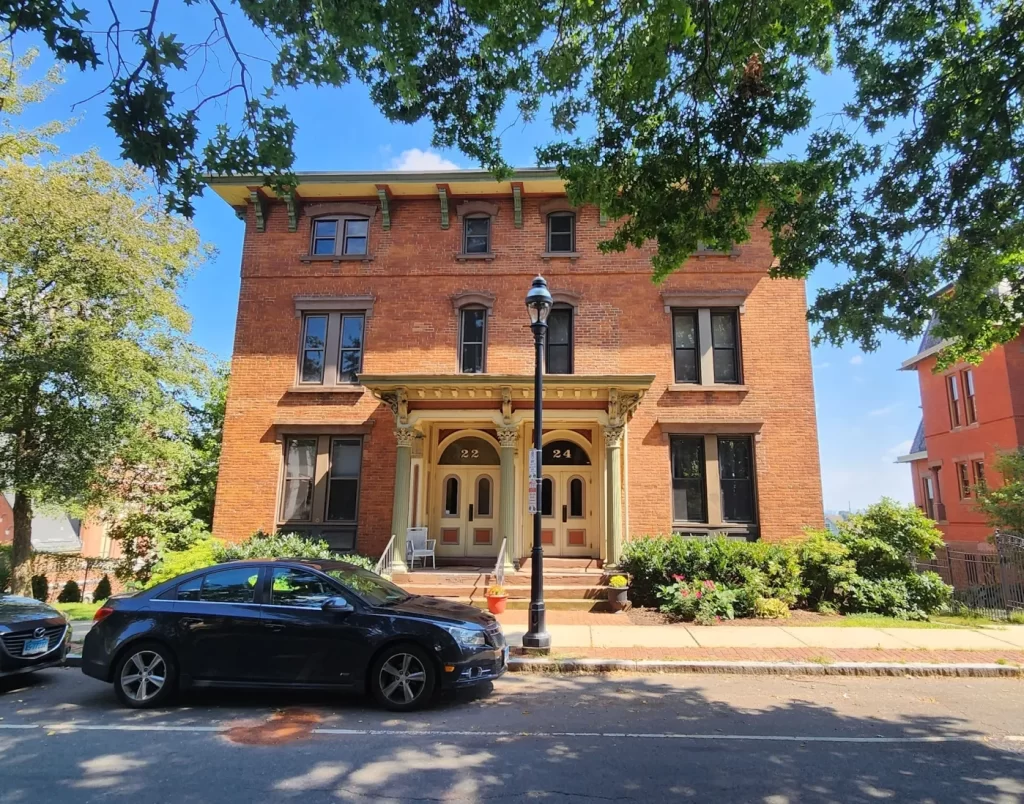My latest video lists the10 youngest towns in Connecticut.
Thompson Exhibition Building (2016)

In 2016, Mystic Seaport celebrated the opening of the new Thompson Exhibition Building, a modern museum facility that makes extensive use of wood and features a dramatic roof that evokes an ocean wave. Designed by Centerbrook Architects and Planners, the building features a 5,000-square-foot exhibition gallery and visitor reception areas.
Harry Strong House (1898)

The Victorian-era house at 46 Main Street in East Hampton was originally the home of Harry W. Strong (1867-1917) and was built not long after he purchased the property in 1898. Strong was a mail agent on the New York, New Haven and Hartford Railroad. He married Cornelia E. Goff in 1885 and the couple had two daughters, who sold the house to descendants of bell manufacturer N. N. Hill in 1942.
Henry Gildersleeve, Jr. House (1888)

In 1888, Henry Gildersleeve, Jr. (1858-1944) erected a grand Victorian-era residence at 624 Main Street in Portland, across the street from the 1853 house erected by his father, the prominent shipbuilder Henry Gildersleeve, Sr. (1817-1894). The career of Henry Gildersleeve, Jr. is described in Gildersleeves of Gildersleeve, Conn. and the Descendants of Philip Gildersleeve, by Willard Harvey Gildersleeve:
Henry Gildersleeve, Jr., graduated in 1875 from Middletown High School and received the degree of B. A, from Wesleyan University in 1879 where he was a member of the football team and of the baseball team. He was also a member of the "Waverleys," a famous old ball club of Portland. In 1881, he received the degree of LL. B., from Columbia University. He spent his vacations and the following year in Hartford, Ct., in the law office of Judge Hammersley of Connecticut Supreme Court. Shortly after he was admitted to the bar in N. Y. City and entered the law office of Messrs. Huntley & Bower. After another year of constant work and study his health was affected, resulting in a serious attack of brain fever. Recovering from the attack, he took chaise of the schooner "Ruth Robinson," and made a trip with it. He then entered the store of S. Gildersleeve & Sons as clerk and becoming interested, was made partner in 1885. He was also part owner of the Gildersleeve and Cromwell Ferry. He organized the Gildersleeve Coal Co. in 1885, was notary public and secretary of the Portland Water Co. In 1900 he sold his interest in the store, having been employed by the Tonawanda Iron & Steel Co., of Tonawanda, N. Y,, on their whaleback steamers. In 1901 he sold the large mansion which he built in 1888 at 624 Main street, Gildersleeve, Ct., to his brother, Oliver, and after working in the Gildersleeve shipyard until 1907, devoted his attention to tobacco raising. Episcopalian. Resides in Gildersleeve, Ct.
The house was later the residence of Oliver’s son Walter Gildersleeve (1874-1949).
Broad Brook Congregational Church (1893)

The Congregational Church in the village of Broad Brook in the Town of East Windsor was first organized in 1849 and their original church building was dedicated in January of 1854. After the church was burned on February 8, 1893, construction began on the current building, which was dedicated on January 24, 1894. As a reporter for the Hartford Courant newspaper noted at the time, “The church as a whole is complete in all its equipments and presents a very neat and cheerful appearance.”
(more…)Schwab-Cook House (1870)

The Italianate-style double house at 22-24 Charter Oak Place in Hartford was erected c. 1869-1871 by Joseph Schwab (1826-1914), an insurance agent, who lived at No. 24. His father Jacob Schawb served in Napoleon’s army and survived the disastrous invasion of Russia, although he never recovered the full use of one of his legs that had been frozen during the Moscow Campaign. Jacob later emigrated to America and became a butcher in New York. His son Joseph Schawb was born in Gruenstadt, Germany. In his youth he worked as a manager for a mercantile house in Bühl, just south of Baden-Baden and during that time supported the German revolutionaries of 1848. He arrived in New York at the age of twenty-eight and worked for a German banking house in the city before joining a dry goods and millinery business in Hartford. When that partnership dissolved in 1877, he went into the insurance business, only retiring in 1912, two years before his death at the age of eighty-eight. In addition to building up a large fire and life insurance writing business, Schawb served as manager for New England of the Germania Life Insurance Company of New York. For forty years he also served as the first president of the Ladies’ Deboarh Society of Hartford, which raised funds to build the 1886 Deborah Chapel at Beth Israel Cemetery in Hartford, a building that was recently demolished. For thirty-seven years he also served on the city’s High School committee, being treasurer for eighteen terms. During that time another building which has since been demolished, the Gothic-style Hartford Public High School, was erected on Hopkins Street.
Betts Farm (1790)

Betts Farm, located at 249 Nod Road in Ridgefield, is an estate consisting of several historic structures, including the main house, an ice house and wood shed, a barn, and an adjacent cottage. The original section of the main house dates to circa 1790. It features an Early Classical Revival-style gable-fronted facade with four Ionic columns and a circular window in the gable. In about 1925 the house was acquired by Henry King McHarg (1851-1942), a railroad tycoon from Albany, New York whose family had roots in Ridgefield. Two years later he married his second wife, Elizabeth Clark Pierce (she was 36 and he was 76) and it is possibly around that time that he joined another, originally separate, house to the rear of the 1790 structure.
(more…)